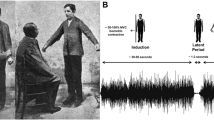Abstract.
Previous studies have argued that tremors of central versus peripheral origin can be distinguished based on their load dependence: the frequency of peripheral tremor decreases when a weight is added to the tremulous limb, while the frequency of central tremors remains unchanged. The present study scrutinizes the latter statement. We simulated central tremor using a simple network of coupled neural oscillators, which receives proprioceptive feedback from the motor periphery. The network produced a self-sustained, stable oscillation. When the gain of proprioceptive feedback was high, oscillation frequency decreased in the presence of an inertial load. When the gain was low, the oscillation frequency was load independent. We conclude that load dependence is not an exclusive property of peripheral tremors but may be found in tremors of central origin as well. Therefore, the load test is not sufficient to reject a central tremor origin.
Similar content being viewed by others
Author information
Authors and Affiliations
Additional information
Received: 1 October 1998 / Accepted in revised form: 28 January 1999
Rights and permissions
About this article
Cite this article
Wenderoth, N., Bock, O. Load dependence of simulated central tremor. Biol Cybern 80, 285–290 (1999). https://doi.org/10.1007/s004220050525
Issue Date:
DOI: https://doi.org/10.1007/s004220050525




